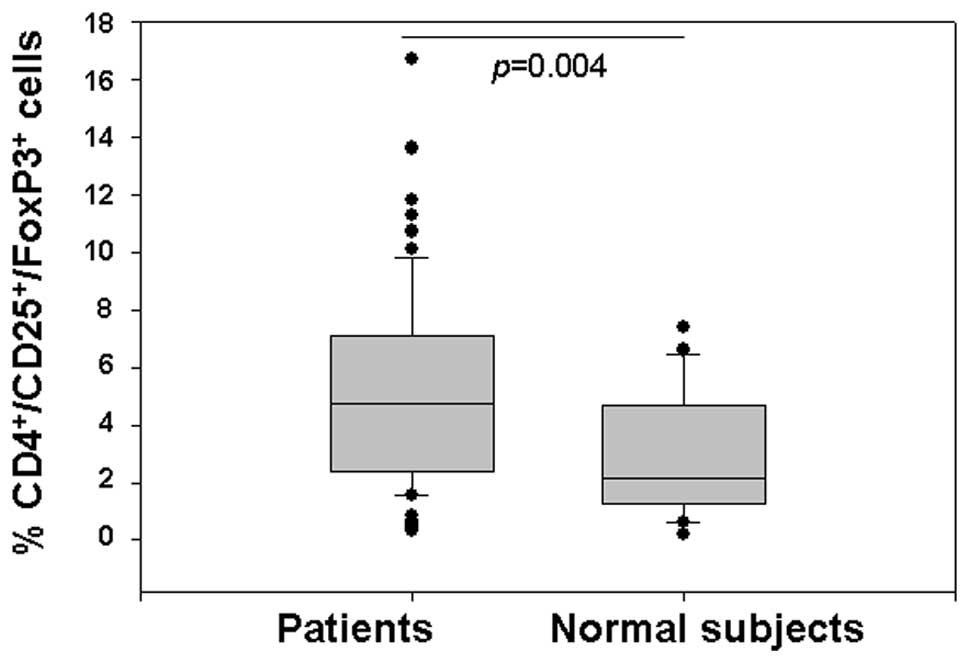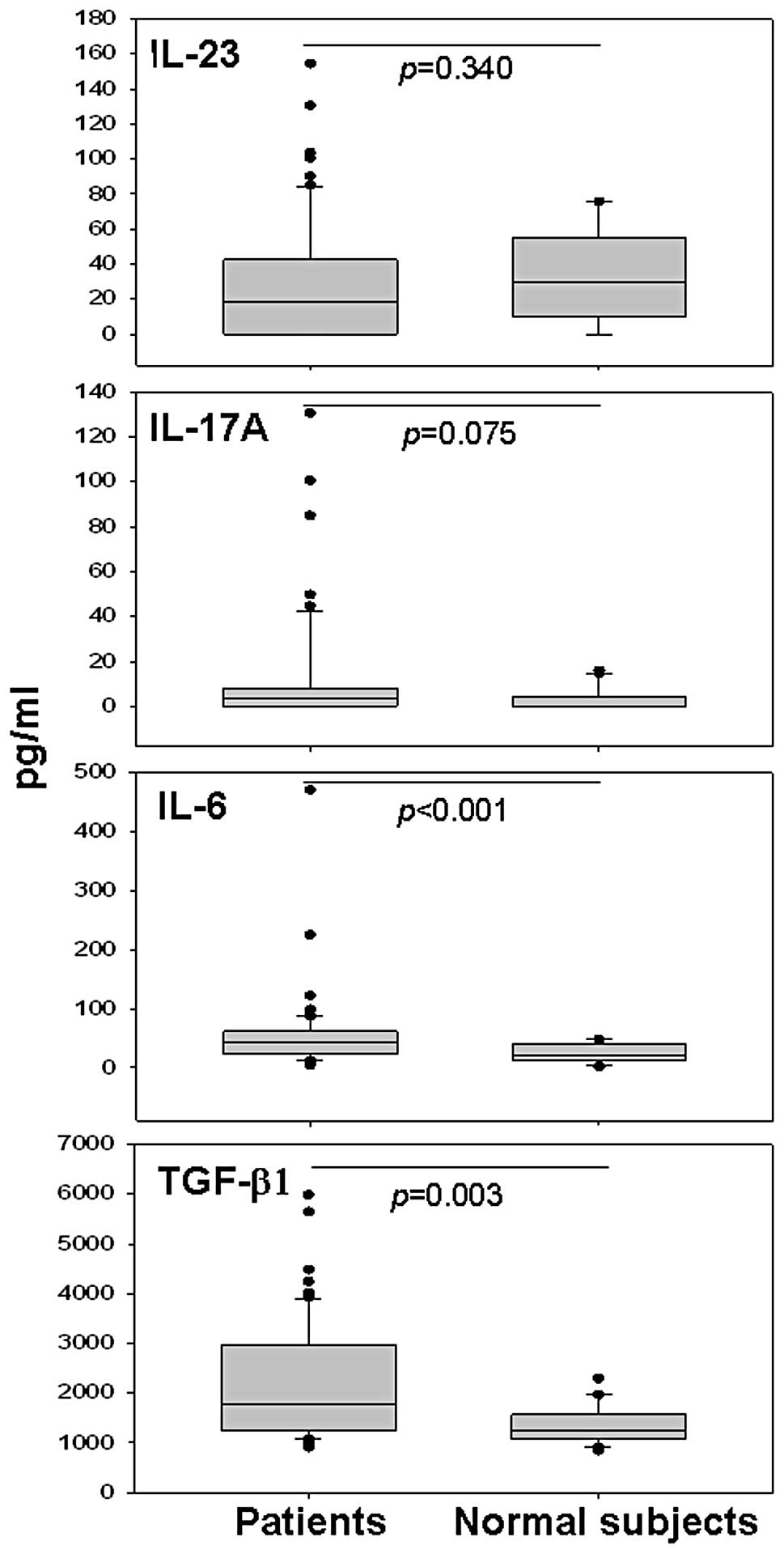|
1
|
Laheru D and Jaffee EM: Immunotherapy for
pancreatic cancer - science driving clinical progress. Nat Rev
Cancer. 5:459–467. 2005. View
Article : Google Scholar : PubMed/NCBI
|
|
2
|
Greer JB and Whitcomb DC: Inflammation and
pancreatic cancer: an evidence-based review. Curr Opin Pharmacol.
9:411–418. 2009. View Article : Google Scholar : PubMed/NCBI
|
|
3
|
Sakaguchi S, Sakaguchi N, Asano M, Itoh M
and Toda M: Immunologic self-tolerance maintained by activated T
cells expressing IL-2 receptor alpha-chains (CD25). Breakdown of a
single mechanism of self-tolerance causes various autoimmune
diseases. J Immunol. 155:1151–1164. 1995.
|
|
4
|
Sakaguchi S and Powrie F: Emerging
challenges in regulatory T cell function and biology. Science.
317:627–629. 2007. View Article : Google Scholar : PubMed/NCBI
|
|
5
|
Erdman SE, Rao VP, Olipitz W, et al:
Unifying roles for regulatory T cells and inflammation in cancer.
Int J Cancer. 126:1651–1665
|
|
6
|
Chen Z and O’Shea JJ: Th17 cells: a new
fate for differentiating helper T cells. Immunol Res. 41:87–102.
2008. View Article : Google Scholar : PubMed/NCBI
|
|
7
|
Bettelli E, Carrier Y, Gao W, et al:
Reciprocal developmental pathways for the generation of pathogenic
effector TH17 and regulatory T cells. Nature. 441:235–238. 2006.
View Article : Google Scholar
|
|
8
|
Boniface K, Blom B, Liu YJ and de Waal
Malefyt R: From interleukin-23 to T-helper 17 cells: human T-helper
cell differentiation revisited. Immunol Rev. 226:132–146. 2008.
View Article : Google Scholar : PubMed/NCBI
|
|
9
|
Ferrone S and Whiteside TL: Tumor
microenvironment and immune escape. Surg Oncol Clin N Am.
16:755–774. viii2007. View Article : Google Scholar : PubMed/NCBI
|
|
10
|
Bellone G, Turletti A, Artusio E, et al:
Tumor-associated transforming growth factor-beta and interleukin-10
contribute to a systemic Th2 immune phenotype in pancreatic
carcinoma patients. Am J Pathol. 155:537–547. 1999. View Article : Google Scholar
|
|
11
|
Bellone G, Carbone A, Smirne C, et al:
Cooperative induction of a tolerogenic dendritic cell phenotype by
cytokines secreted by pancreatic carcinoma cells. J Immunol.
177:3448–3460. 2006. View Article : Google Scholar : PubMed/NCBI
|
|
12
|
Wolf AM, Wolf D, Steurer M, Gastl G,
Gunsilius E and Grubeck-Loebenstein B: Increase of regulatory T
cells in the peripheral blood of cancer patients. Clin Cancer Res.
9:606–612. 2003.PubMed/NCBI
|
|
13
|
Ichihara F, Kono K, Takahashi A, Kawaida
H, Sugai H and Fujii H: Increased populations of regulatory T cells
in peripheral blood and tumor-infiltrating lymphocytes in patients
with gastric and esophageal cancers. Clin Cancer Res. 9:4404–4408.
2003.PubMed/NCBI
|
|
14
|
Ormandy LA, Hillemann T, Wedemeyer H,
Manns MP, Greten TF and Korangy F: Increased populations of
regulatory T cells in peripheral blood of patients with
hepatocellular carcinoma. Cancer Res. 65:2457–2464. 2005.
View Article : Google Scholar : PubMed/NCBI
|
|
15
|
Viguier M, Lemaitre F, Verola O, et al:
Foxp3 expressing CD4+CD25(high) regulatory T cells are
overrepresented in human metastatic melanoma lymph nodes and
inhibit the function of infiltrating T cells. J Immunol.
173:1444–1453. 2004.
|
|
16
|
Liyanage UK, Moore TT, Joo HG, et al:
Prevalence of regulatory T cells is increased in peripheral blood
and tumor microenvironment of patients with pancreas or breast
adenocarcinoma. J Immunol. 169:2756–2761. 2002. View Article : Google Scholar : PubMed/NCBI
|
|
17
|
North RJ and Bursuker I: Generation and
decay of the immune response to a progressive fibrosarcoma. I.
Ly-1+2- suppressor T cells down-regulate the generation of Ly-1-2+
effector T cells. J Exp Med. 159:1295–1311. 1984.
|
|
18
|
Hiura T, Kagamu H, Miura S, et al: Both
regulatory T cells and antitumor effector T cells are primed in the
same draining lymph nodes during tumor progression. J Immunol.
175:5058–5066. 2005. View Article : Google Scholar : PubMed/NCBI
|
|
19
|
Walker LS, Chodos A, Eggena M, Dooms H and
Abbas AK: Antigen-dependent proliferation of CD4+
CD25+ regulatory T cells in vivo. J Exp Med.
198:249–258. 2003. View Article : Google Scholar : PubMed/NCBI
|
|
20
|
Yamagiwa S, Gray JD, Hashimoto S and
Horwitz DA: A role for TGF-beta in the generation and expansion of
CD4+CD25+ regulatory T cells from human
peripheral blood. J Immunol. 166:7282–7289. 2001. View Article : Google Scholar : PubMed/NCBI
|
|
21
|
Curiel TJ, Coukos G, Zou L, et al:
Specific recruitment of regulatory T cells in ovarian carcinoma
fosters immune privilege and predicts reduced survival. Nat Med.
10:942–949. 2004. View
Article : Google Scholar : PubMed/NCBI
|
|
22
|
Merlo A, Casalini P, Carcangiu ML, et al:
FOXP3 expression and overall survival in breast cancer. J Clin
Oncol. 27:1746–1752. 2009. View Article : Google Scholar : PubMed/NCBI
|
|
23
|
Schaefer C, Kim GG, Albers A, Hoermann K,
Myers EN and Whiteside TL: Characteristics of
CD4+CD25+ regulatory T cells in the
peripheral circulation of patients with head and neck cancer. Br J
Cancer. 92:913–920. 2005.
|
|
24
|
Kono K, Kawaida H, Takahashi A, et al:
CD4(+)CD25high regulatory T cells increase with tumor stage in
patients with gastric and esophageal cancers. Cancer Immunol
Immunother. 55:1064–1071. 2006.
|
|
25
|
Stein-Streilein J and Taylor AW: An eye’s
view of T regulatory cells. J Leukoc Biol. 81:593–598. 2007.
|
|
26
|
Bellone G, Smirne C, Mauri FA, et al:
Cytokine expression profile in human pancreatic carcinoma cells and
in surgical specimens: implications for survival. Cancer Immunol
Immunother. 55:684–698. 2006. View Article : Google Scholar : PubMed/NCBI
|
|
27
|
Lee YK, Mukasa R, Hatton RD and Weaver CT:
Developmental plasticity of Th17 and Treg cells. Curr Opin Immunol.
21:274–280. 2009. View Article : Google Scholar : PubMed/NCBI
|
|
28
|
Kimura A and Kishimoto T: IL-6: regulator
of Treg/Th17 balance. Eur J Immunol. 40:1830–1835. 2010. View Article : Google Scholar : PubMed/NCBI
|
|
29
|
Wrzesinski SH, Wan YY and Flavell RA:
Transforming growth factor-beta and the immune response:
implications for anticancer therapy. Clin Cancer Res. 13:5262–5270.
2007. View Article : Google Scholar : PubMed/NCBI
|
|
30
|
Veldhoen M, Hocking RJ, Atkins CJ,
Locksley RM and Stockinger B: TGFbeta in the context of an
inflammatory cytokine milieu supports de novo differentiation of
IL-17-producing T cells. Immunity. 24:179–189. 2006. View Article : Google Scholar
|
|
31
|
Zhang JP, Yan J, Xu J, et al: Increased
intratumoral IL-17-producing cells correlate with poor survival in
hepatocellular carcinoma patients. J Hepatol. 50:980–989. 2009.
View Article : Google Scholar : PubMed/NCBI
|
|
32
|
Chen X, Wan J, Liu J, et al: Increased
IL-17-producing cells correlate with poor survival and
lymphangiogenesis in NSCLC patients. Lung Cancer. 69:348–354
|
|
33
|
Kryczek I, Banerjee M, Cheng P, et al:
Phenotype, distribution, generation, and functional and clinical
relevance of Th17 cells in the human tumor environments. Blood.
114:1141–1149. 2009. View Article : Google Scholar : PubMed/NCBI
|
|
34
|
Gaffen SL: An overview of IL-17 function
and signaling. Cytokine. 43:402–407. 2008. View Article : Google Scholar : PubMed/NCBI
|
|
35
|
Langowski JL, Zhang X, Wu L, et al: IL-23
promotes tumour incidence and growth. Nature. 442:461–465. 2006.
View Article : Google Scholar : PubMed/NCBI
|
|
36
|
Langowski JL, Kastelein RA and Oft M:
Swords into plowshares: IL-23 repurposes tumor immune surveillance.
Trends Immunol. 28:207–212. 2007. View Article : Google Scholar : PubMed/NCBI
|
|
37
|
Numasaki M, Fukushi J, Ono M, et al:
Interleukin-17 promotes angiogenesis and tumor growth. Blood.
101:2620–2627. 2003. View Article : Google Scholar : PubMed/NCBI
|
|
38
|
Kortylewski M, Xin H, Kujawski M, et al:
Regulation of the IL-23 and IL-12 balance by Stat3 signaling in the
tumor micro-environment. Cancer Cell. 15:114–123. 2009. View Article : Google Scholar : PubMed/NCBI
|
|
39
|
Weaver CT, Harrington LE, Mangan PR,
Gavrieli M and Murphy KM: Th17: an effector CD4 T cell lineage with
regulatory T cell ties. Immunity. 24:677–688. 2006. View Article : Google Scholar : PubMed/NCBI
|
|
40
|
Carbone A, Vizio B, Novarino A, et al:
IL-18 paradox in pancreatic carcinoma: elevated serum levels of
free IL-18 are correlated with poor survival. J Immunother.
32:920–931. 2009. View Article : Google Scholar : PubMed/NCBI
|
|
41
|
Bellone G, Carbone A, Busso V, et al:
Antagonistic interactions between gemcitabine and 5-fluorouracil in
the human pancreatic carcinoma cell line Capan-2. Cancer Biol Ther.
5:1294–1303. 2006. View Article : Google Scholar : PubMed/NCBI
|
|
42
|
Correale P, Rotundo MS, Del Vecchio MT, et
al: Regulatory (FoxP3+) T-cell tumor infiltration is a
favorable prognostic factor in advanced colon cancer patients
undergoing chemo or chemoimmunotherapy. J Immunother.
33:435–441
|
|
43
|
Suzuki E, Kapoor V, Jassar AS, Kaiser LR
and Albelda SM: Gemcitabine selectively eliminates splenic
Gr-1+/CD11b+ myeloid suppressor cells in
tumor-bearing animals and enhances antitumor immune activity. Clin
Cancer Res. 11:6713–6721. 2005.PubMed/NCBI
|
|
44
|
Fengming K, Anscher MS, Zhiping X and
Jirtle RL: Elevated circulating transforming growth factor beta1
(TGFβ1) levels decreased after radiotherapy in patients with lung
cancer, cervical cancer and Hodgkin’s disease: a possible tumor
marker. Int J Radiat Oncol Biol Phys. 32:2391995.
|
|
45
|
Fujimoto-Ouchi K, Onuma E, Shirane M, Mori
K and Tanaka Y: Capecitabine improves cancer cachexia and
normalizes IL-6 and PTHrP levels in mouse cancer cachexia models.
Cancer Chemother Pharmacol. 59:807–815. 2007. View Article : Google Scholar : PubMed/NCBI
|
|
46
|
Gounaris E, Blatner NR, Dennis K, et al:
T-regulatory cells shift from a protective anti-inflammatory to a
cancer-promoting proinflammatory phenotype in polyposis. Cancer
Res. 69:5490–5497. 2009. View Article : Google Scholar : PubMed/NCBI
|
















